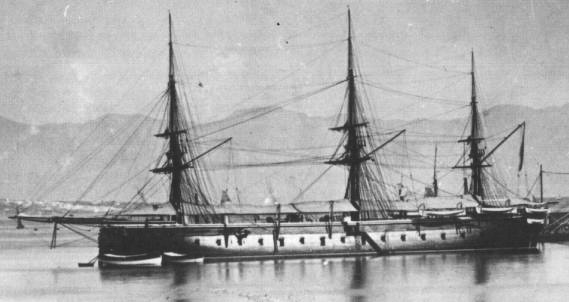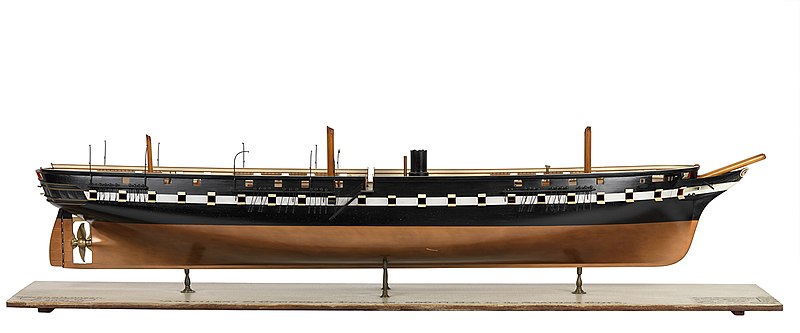
Arapiles was a Spanish broadside ironclad, wooden hulled armoured frigate built in England, launched in 1864 and in service until 1882. She was bought on the stocks, for the Spanish Navy, while being started at Green, Blackwall, London in June 1861 as an unarmored steam frigate. She was then purchased and converted into an ironclad while under construction. In 1873 she was damaged after running aground and repaired in the United States during the Virginius Affair and tensions between the US and Spain. She was hulked in 1879, but never sailed again. She was inspected in 1882 and her hull’s poor condition forced her reconstruction to be cancelled in 1882 so she was scrapped afterwards. #armada #arapiles #cantonalwar #carlistwar #1898 #ironclad #spanishnavy #blackwall #virginiusaffair

The previous vessel, as a steam frigate in 1861
Design of Arapiles
Arapiles was named for the hills at the Battle of Salamanca. She was purchased while in construction on the stocks, while building at Green shipyard in Blackwall, London. Her conversion into an ironclad started by August 1862 so barely a year after she was laid down, and she received some roughly 200 long tons (203 t) of wrought iron armor while her armament was amended on demand by the Spaniared. She was launched on 17 October 1864, completed in 1865.
Hull and general design
Arapiles displaced 3,441 long tons (3,496 t). She was 280 feet (85.3 m) long at the waterline, for a beam of 52 feet 2 inches (15.9 m) and draft of 17 feet (5.2 m). Her rigging was three masts, barque, with three sail stages (course, topmast, royal) and three stud sails, three jibs. This compensated for the lack of range as usual of her high consumption steam engine.
Powerplant
Arapules had a single trunk steam engine, with steam provided by six cylindrical single-ended coil burning boilers exhausting into to a single low funnel. It passed on power to a single propeller shaft, four bladed bronze, not removable, fixed pitch. It had been designed for an output of 2,400 indicated horsepower (1,800 kW) and on paper speed of 8 knots (15 km/h; 9.2 mph).
Armament
Arapiles was a broadside ironclad, yet she had two heavy main guns, Armstrong 10-inch (254 mm) and five 8-inch (203 mm) rifled muzzle-loading guns in the center of the main artillery deck completed by ten 68-pounder smoothbore guns fore and aft of these. Due to the state of her hull ten years after, apparently completely rotten, her modernization never happened. She was decommissioned with the same armament as she entered service.
Protection
Sources differ on her wrought-iron armor thickness, which happened to have range between 3 to 5 inches (76 to 127 mm) thick. The deck was not armoured and there was no conning tower.

⚙ specifications |
|
| Displacement | 3,441 long tons (3,496 t) |
| Dimensions | 280 ft x 52 ft 2 in x 17 ft (85.3 x 15.9 x 5.2 m) |
| Propulsion | 1c shaft Trunk steam engine, 6 boilers: 2,400 ihp (1,800 kW) |
| Speed | about 8 knots (15 km/h; 9.2 mph) |
| Range | |
| Armament | 2× 9-in RML, 5× 8-in RML, 10× 68-pdr smoothbore |
| Protection | Belt: 114 mm (4.5 in), Battery: 100 mm (3.9 in) |
| Crew | 537 |
Career of Arapiles

After completion, Arapiles could not leave for Spain as soon as she was ready, due to diplomatic pressure as the Spain was still raging with Chile and Peru. The United Kingdom enforced her neutrality agreements not to refuse her to depart, but to be provided state coal, except she was heading in international waters and met a coaler. There was also a clause of seizure of any warship under construction for a belligerent country.
At last, she could obtain coal and depart after the armistice of February 18, 1868 was signed between Spain and Chile, it should be noted that ships for Chile were also in construction and were unblocked afterwards.
In 1871, Arapiles was assigned to Spanish Algiers station trying to protect nationals after Kabyle revolution (border tribes), taking advantage of the Franco-Prussian War. Indeed, the city was part of the French mandate in the former “Barbary state”. Once her mission was completed, she was sent to the maritime exhibition in Naples, representing Spain during an international archaeological commission of scientists embarked that was about to depart for the Near East, and she was in escort as well as to “showing the flag”, after more than 80 years without any Spanish warship in those waters. The Spanish plan was just to acquire pieces from this area for the national Museum, the newly founded National Archaeological Museum of Madrid.
After completing this scientific expedition, Arapiles sailed to Spanish Havana. In 1867, she suffered a serious machinery breakdown while off the coast of Venezuela. She was transferred to Fort-de-France (French Caribbean) for emergency repairs, to be completed later in New York. There in Martinique, the crew learned by newspapers about the Virginius affair.
The Virginius Affair was a diplomatic dispute from October 1873 to February 1875 between the United States, Great Britain and Spain about the control of Cuba in the ten Years’ War. Virginius was a fast American ship hired by Cuban insurrectionists, used to land men and munitions in Cuba. It was captured by the Spanish which put the men on trial, some being American and British. They were declared as pirates and sentenced to death, all 53 being hanged before they could be saved by the British governor.
The affaur created an outrage in the US and there were concerns the latter might declare war on Spain. Lengthy negotiations were unlocked as there was a change of regime in spain, and in the end, US consul Caleb Cushing negotiated $80,000 in reparations paid to the families of the executed Americans. British families had been already compensated prior. The peaceful settlement implemented by US Secretary of State Hamilton Fish avoided a costly war between the United States and Spain, that was not going in favor of the former on paper, naval wise. The Virginius Affair started also a new interest in the US Navy, or more precisely, the need to beef it up. It was in 1898 when the US ultimately declared war this time.

Arapiles in drydock repairs La Havana 1870
Arapiles’ repairs in New York were thus cancelled until the following spring, and by the fall of 1872, stormy weather prevented her to depart. Instead, after repairs, she sailed back to Guantánamo of Cuba. In May 1873, she set sail at last for New York with the steamship Isabel la Católica for full repairs. By January 23, 1874, she departed again for Havana, and stayed on station until 1878. At that stage, the jot and humid local climate had not been tender with her wooden hull.
The crew already could see it was riddled with various bugs and worms, and a commission examined her in detail, concluding her hull seemed in effect rotten. But it was considered safe enough to sail for Spain and undergo the complete modernization she needed.
To be certain, the construction inspector asked to remove the armour to examine the hull underneath. The naval staff thus decided to have her provisionally discharged from the Navy, and she was decommissioned in 1878. Soon after, she was berthed so that her armour could be removed, exposing the inner hull and conforming the worst fears. Her poor condition forced this time the official cancellation of her reconstruction planned for 1882. Instead, she was likely scrapped in 1883 or 1884 at the arsenal of La Carraca in Cádiz.
Read More/Src
Books
Spanish Ironclads Tetuan, Mendes Nunes and Arapiles”, p. 408
“Richard Green statue”. PMSA Public Monuments & Sculpture Association. Archived from the original on 6 October 2014.
Brassey, Thomas (1888). The Naval Annual 1887. Portsmouth, England: J. Griffin.
Lyon, Hugh (1979). “Spain”. In Gardiner, Robert (ed.). Conway’s All the World’s Fighting Ships 1860–1905. Greenwich: Conway Maritime Press
de Saint Hubert, Christian (1984). “Early Spanish Steam Warships, Part II”. Warship International.
Silverstone, Paul H. (1984). Directory of the World’s Capital Ships. New York: Hippocrene Books.
Spanish Ironclads Tetuan, Mendes Nunes and Arapiles”. Warship International. XI (2): 407–408. 1974.
Gardiner, Robert, ed. (1979). Conway’s All the World’s Fighting Ships 1860-1905. Greenwich: Conway Maritime Press
de Saint Hubert, Christian (1984). «Early Spanish Steam Warships, Part II». Warship International
Silverstone, Paul H. (1984). Directory of the World’s Capital Ships. NY Hippocrene Books
Links
books.google.f
todoavante.es
alojados.revistanaval.com/
es.wikipedia.org/ Arapiles


 Latest Facebook Entry -
Latest Facebook Entry -  X(Tweeter) Naval Encyclopedia's deck archive
X(Tweeter) Naval Encyclopedia's deck archive Instagram (@navalencyc)
Instagram (@navalencyc)





 French Navy
French Navy Royal Navy
Royal Navy Russian Navy
Russian Navy Armada Espanola
Armada Espanola Austrian Navy
Austrian Navy K.u.K. Kriegsmarine
K.u.K. Kriegsmarine Dansk Marine
Dansk Marine Nautiko Hellenon
Nautiko Hellenon Koninklije Marine 1870
Koninklije Marine 1870 Marinha do Brasil
Marinha do Brasil Osmanlı Donanması
Osmanlı Donanması Marina Do Peru
Marina Do Peru Marinha do Portugal
Marinha do Portugal Regia Marina 1870
Regia Marina 1870 Nihhon Kaigun 1870
Nihhon Kaigun 1870 Preußische Marine 1870
Preußische Marine 1870 Russkiy Flot 1870
Russkiy Flot 1870 Svenska marinen
Svenska marinen Søværnet
Søværnet Union Navy
Union Navy Confederate Navy
Confederate Navy Armada de Argentina
Armada de Argentina Imperial Chinese Navy
Imperial Chinese Navy Marinha do Portugal
Marinha do Portugal Mexico
Mexico Kaiserliche Marine
Kaiserliche Marine 1898 US Navy
1898 US Navy Sovietskiy Flot
Sovietskiy Flot Royal Canadian Navy
Royal Canadian Navy Royal Australian Navy
Royal Australian Navy RNZN Fleet
RNZN Fleet Chinese Navy 1937
Chinese Navy 1937 Kriegsmarine
Kriegsmarine Chilean Navy
Chilean Navy Danish Navy
Danish Navy Finnish Navy
Finnish Navy Hellenic Navy
Hellenic Navy Polish Navy
Polish Navy Romanian Navy
Romanian Navy Turkish Navy
Turkish Navy Royal Yugoslav Navy
Royal Yugoslav Navy Royal Thai Navy
Royal Thai Navy Minor Navies
Minor Navies Albania
Albania Austria
Austria Belgium
Belgium Columbia
Columbia Costa Rica
Costa Rica Cuba
Cuba Czechoslovakia
Czechoslovakia Dominican Republic
Dominican Republic Haiti
Haiti Hungary
Hungary Honduras
Honduras Estonia
Estonia Iceland
Iceland Eire
Eire Equador
Equador Iran
Iran Iraq
Iraq Latvia
Latvia Liberia
Liberia Lithuania
Lithuania Mandchukuo
Mandchukuo Morocco
Morocco Nicaragua
Nicaragua Persia
Persia San Salvador
San Salvador Sarawak
Sarawak Uruguay
Uruguay Venezuela
Venezuela Zanzibar
Zanzibar Warsaw Pact Navies
Warsaw Pact Navies Bulgaria
Bulgaria Hungary
Hungary

 Bundesmarine
Bundesmarine Dutch Navy
Dutch Navy Hellenic Navy
Hellenic Navy Marina Militare
Marina Militare Yugoslav Navy
Yugoslav Navy Chinese Navy
Chinese Navy Indian Navy
Indian Navy Indonesian Navy
Indonesian Navy JMSDF
JMSDF North Korean Navy
North Korean Navy Pakistani Navy
Pakistani Navy Philippines Navy
Philippines Navy ROKN
ROKN Rep. of Singapore Navy
Rep. of Singapore Navy Taiwanese Navy
Taiwanese Navy IDF Navy
IDF Navy Saudi Navy
Saudi Navy Royal New Zealand Navy
Royal New Zealand Navy Egyptian Navy
Egyptian Navy South African Navy
South African Navy






























 Ukrainian Navy
Ukrainian Navy dbodesign
dbodesign